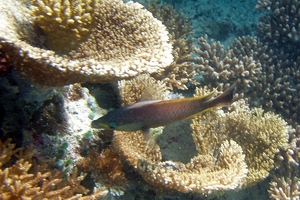Description
Also known as Long-jawed Wrasse, Maori Wrasse, Slingjaw, Telescopefish, Thicklip Wrasse.
Found singly, over drop-offs and along deep slopes, of lagoons and seaward reefs, rich in coral growth. The mouth of this wrasse extends like a telescope, to half the length of it's own body when catching prey. Geographical colour variations.
They feed on coral dwelling crustaceans and fish.
Length - 30cm
Depth - 1-42m
Widespread Indo-Pacific
Most reef fish seen by divers during the day, are grazers, they cruise around, just above the surface of the coral, or snoop into crevices, foraging for food.
Wrasses have small protruding teeth, which they use to graze the bottom, taking in a variety of algae, crustaceans, such as crabs, eggs, shrimps, snails and worms. Any hard coats or thick shells, are then ground down by their pharyngeal jaws, and the delicacies inside digested.
From juvenile to adult, wrasses dramatically alter their colour and body shapes.
Wrasses are always on the go during the day, but are the first to go to bed and the last to rise.
Small wrasses dive below the sand to sleep, and larger wrasses wedge themselves in crevices. Ref: https://www.fishbase.se/summary/5606










































0 comments